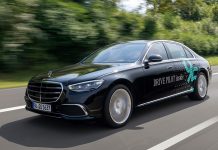Mercedes-Benz has announced a new upgrade for its Level 3 Drive Pilot ADAS that will allow the system to follow a vehicle on the motorway at up to 95 km/h (59 mph). Mercedes-Benz expect the upgraded feature to be re-certified by the German Federal Motor Transport Authority by the end of 2024, after which the OEM can roll it out at the beginning of 2025.
Following the launch of this new version of Drive Pilot, Mercedes-Benz confirmed that its pricing will remain the same, starting at €5,950 ($6,615 / £4,969), while existing owners will receive the upgrade free of charge. Depending on their model, the upgrade can be carried out either as a wireless over-the-air update or through a visit to the customer’s nearest workshop.
By increasing the top speed of Drive Pilot, Mercedes-Benz is aiming to broaden the system’s range of use cases for customers. Today, the system can be used under certain conditions in flowing traffic on the right-hand lane of a motorway while following a vehicle in front. Following the new update, users will continue to be able to use the system in dense traffic conditions and traffic jams on suitable freeways. Once activated, and while the driving task is temporarily handed over to Drive Pilot, Mercedes-Benz says that drivers can engage in secondary activities such as working and internet browsing as well as watching TV or streaming movies through MBUX services such as RIDEVU, a streaming service owned by Sony Pictures Entertainment.
Mercedes‑Benz highlighted the significance of its redundant system architecture for Drive Pilot. Here, vital systems such as steering, braking and the on-board electrical system are functionally redundant to ensure maneuverability in the rare event one of these systems fails. These redundancies help to ensure a safe handover to the driver while on-board cameras, radars, ultrasonic sensors and a LiDAR are used to perceive the car’s environment and process it in real-time.
Using a high-precision positioning system, a Mercedes-Benz vehicle equipped with the ADAS can determine its exact location to within a few centimeters. This localization is made possible by the vehicle requesting this position from all available satellite systems. Drive Pilot then calculates the car’s position based on the data received from the different satellite systems. In addition, an extremely detailed and continuously updated HD map provides a three-dimensional view of streets and surroundings. It is this combination, Mercedes-Benz says, is crucial to enabling safe, conditionally automated, driving.
In Germany, the permitted top speed for conditionally automated driving is currently 130 km/h. By the end of the decade, Mercedes‑Benz is aiming to reach this milestone following a step-by-step approach focused on safety. These R&D activities are being engaged alongside further developments for Drive Pilot, with Mercedes-Benz having already developed special turquoise marker lights for conditionally automated driving (based on SAE J3134 recommendation) that indicate its operating status.
The OEM likewise considers it important to signal to other road users that the conditionally automated driving function is activated. The U.S. states of Nevada and California have already granted exemptions for this technology, and testing is already underway. The turquoise marker lights are integrated into the front and rear lights as well as the two outside mirrors of the Mercedes‑Benz test vehicles. In Germany, there is no legal framework in place for this technology though Mercedes‑Benz plans to adapt the system architecture of Drive Pilot in accordance with the defined standards as they evolve.














